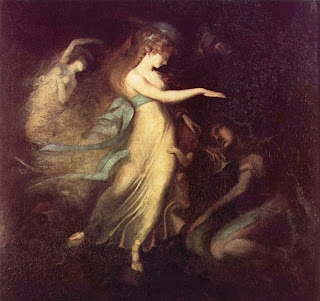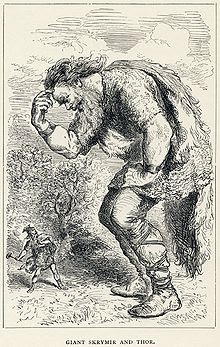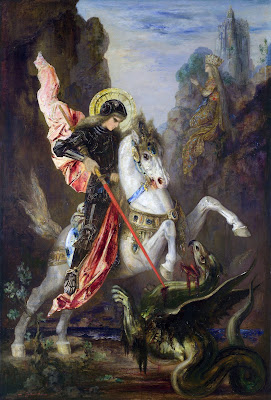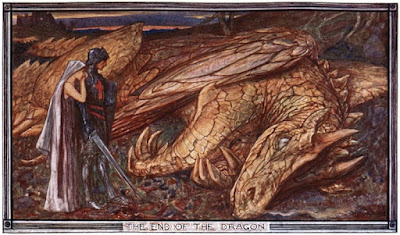By Gyaunt proud opprest,
Prince Arthur meets with Vna great-
ly with those newes distrest.
brings Arthur to the fight:
Who slayes the Gyant, wounds the beast,
and strips Duessa quight.
The knight knit friendly bands;
Sir Treuisan flies from Despayre,
Whom Redcrosse kight withstands.
Her faithfull knight faire Una brings
to house of Holinesse,
Where he is taught repentance, and
the way to heauenly blesse.
Una decides to take Redcrosse to the house of a woman named Caelia, a place of virtue and tranquility, where upon reaching it, they are guided inside by a happy franklin named Zele, and a squire. Una and Caelia embrace, overjoyed to see each other, although Caelia is surprised to see Redcrosse, as few find them on this narrow path. Her daughters, Fidelia and Speranza, enter, the former in white and carrying a gold cup of wine and water, and the latter clad in blue, yet not so happy as her sister as she holds a silver anchor as she prays. After a rest, Redcrosse is taken to be instructed by Fidelia in good virtuous conduct and the avoidance of sin. Yet when the knight begins to despair at his poor behaviour, he is comforted by Speranza (hope), however he still desires death. Una, concerned at his mental state, finds a “Leech” called Patience, and thus Redcrosse begins the healing of his sin, while Amendment, Penance, Remorse, and Repentance subject him to painful, but purifying, experiences. Una feels his every pain as she sees his struggles but patience wins out, and when his conscience is cured, they visit another sister, Charissa, who has just gone through childbirth. From her, Redcrosse learns of love and righteousness and also is schooled by another woman, Mercy, in the art of graciousness and liberality.
Redcrosse is taken to a Hospital of holiness where seven bearded men have given their lives and service to the heavenly king. The eldest, the Guardian, has charge and government of the house; the Almer feeds the hungry; the master of the wardrobe distributes the clothes and if he has none, he’d gives his own; the man who assists prisoners and pays their ransom; the man who comforts the sick, especially at the end of their lives; the one who ensures that the dead have a proper burial; and a man who aids the widows and orphans, supplying their needs. Redcrosse rests there awhile and then climbs a hill to a chapel where an old man, Contemplation, is praying ceaselessly. Grudgingly, Contemplation agrees to help Redcrosse and takes him to a glorious mountain from which they view the City of God. It is Jerusalem, although Redcrosse notes that while Cleopolis, the city of the Faerie Queene is very fair, it is earthly and cannot compare to the heavenly realms. Redcrosse is now ready to complete his task, and when he has, Contemplation instructs him to return and he will be dubbed Saint George. Redcrosse does not feel equal to the task, but the old man reminds him of his promise. When Redcrosse returns, Una is overjoyed to see him and they take leave of the House of Holiness.
The knight with that old Dragon fights
two dayes incessantly;
The third him ouerthrown, and gayns
most glorious victory.
Thinking of her parents, the two approach the kingdom, where they soon spy the dragon lying on a hill. Noting their approach, he rouses himself, whereupon Redcrosse sends Una up a hill to watch the battle, and the narrator is so unsettled that he calls on his Muse for help with his narration. The dragon is as vast as many tracts of land, his scaly body “swolne with wrath, & poyson, & with bloudy gore.” His wings were like the sails of ships, his tail thick, long and pointed with stings, and his mouth and jaws ….. well, let Spenser tell it:
“….. But his most hideous head my toung to tell,
Does tremble: for his deepe deuouring iawes
Wide gaped, like the griesly mouth of hell,
Through which into this dark abisse all rauin fell.
And that more wondrous was, in either iaw
Three ranckes of yron teeth enraunged were,
In which yet trickling bloud and gobbets raw
Of late deuoured bodies did appeare,
That sight thereof bred cold congealed feare:
Which to increase, and all atonce to kill,
A cloud of smoothering smoke and sulphur scare
Out of his stinking gorge forth steemed still,
That all the ayre about with smoke and stench did fill.”
Charging, he bounds almost in joy at his “guest”, and while Redcrosse tries to spear him, the weapon cannot pierce his scaly skin. The dragon becomes annoyed that he cannot strike the knight and grasps Redcrosse and his horse, carrying them away, but finds them too heavy and lands upon the ground. Redcrosse finally manages to gain a hit on the dragon’s wing, enraging the beast, who is unused to such treatment. Bleeding profusely, the dragon hits Redcrosse’s horse and unseats the knight, who tries to strike the dragon on the head, but does not manage to wound the beast. The dragon sends a stream of fire, searing Redcrosse in his armour. “Faint, wearie, sore, emboyled, grieued, brent with heat and toil, sounds, armes, smart, & inward fire”, the knight is so injured that he wishes for death, finally falling backwards into something he never expected:
“… Behind his backe vnweeting, where he stood,
Of auncient time there was a springing well,
From which fast trickled forth a siluer flood,
Full of great vertues, and for med’cine good.
Whylome, before that cursed Dragon got
That happie land, and all with innocent blood
Defyld those sacred waues, it rightly hot
The well of life, ne yet his vertues had forgot.”
Una fears for her knight’s life as he lays there overnight, and she prays for his recovery. How astounded she is in the morning to see him spring from the well, and not only is his body renewed and strengthened, his blade as well, but from what cause is not certain. He strikes the dragon on the skull, making a gaping wound. The dragon hits Redcrosse with his tail, stabbing him in his shoulder, whereupon Redcrosse answers by amputating the dragon’s tail. Infuriated, the dragon flies up, then down, grasping the knight’s shield with his claws, but Redcrosse manages to cut off the claws but the foot still holds. The dragon shoots flames again, and Redcrosse retreats, slipping on some mud into another saviour from death, the tree of life. Another night passes, with Una devotely praying, and Redcrosse again is renewed in the morning. The dragon tried to devour Redcrosse with a wide open maw, but Redcrosse stabs him through the mouth, killing the beast, and its fall is so terrible that both Una and Redcrosse are stunned until he realizes his victory, and Una gives thanks to God.
Faire Una to the Redcrosse knight
betrouthed is with joy:
Though false Duessa it to barre
her false sleights doe imploy.
A watchman tells the King and Queen about the fall of the dragon. The kingdom rejoices to be released from the terror of the beast, thanking Redcrosse and throwing laurels at his feet while dancing around. Music fills the air as the maidens crown Una, a virgin fair. Yet the people’s fear of the dragon keeps them from approaching to close to it, in case its death is not complete. The king bestows Redcrosse with gifts of ivory and gold and thanks, kisses his daughter and brings both to the palace while the people sing and strew garments at their feet. There is a feast where Redcrosse recounts his adventures. The king sheds a tear, not knowing whether to bestow praise or pity on his deliverer but counsels rest. Yet Redcrosse cannot accept any repose because he owes six years of his service to The Faerie Queene, but the king proclaims that when the six years are over Redcrosse will return to take Una’s hand in marriage and his kingdom. Una enters, appearing like a fresh flower as she’s shed the black garments and veil, and Redcrosse has never seen her more beautiful. However, a messenger runs in, reading a letter from Duessa/Fidessa stating that Redcrosse is unable to marry Una as he is pledged to her. Redcrosse sits astonished without a word, but finally the king demands an explanation. Redcrosse proclaims his innocence, as he was tricked by the false and wicked woman, when he had strayed from the right path. Una supports his story, and claims the messenger is Archimago himself. They grab and bind him, and put him in the dungeon, then the king binds Una to Redcrosse with sacred vows and holy water. The feasting commences, with music and jollity. Redcrosse’s blissful time with Una lasts long, until he remembers his vow to The Faerie Queene and Una mourns his leaving.
Here is a chart of some of the characters and the symbolism within each, which I found very helpful:
Characters_ _Moral_ _Religious and _Personal and
Spirtual_ Political_
Redcross Knight Holiness Reformed England St George
Una Truth True Religion
Prince Arthur Magnificence, or Protestantism, or Lord Leicester
Private Virtue the Church Militant
Gloriana Glory Spirtual Beauty Queen Elizabeth
Archimago Hypocrisy The Jesuits Phillip II of Spain
Duessa Falsehood False Religion Mary Queen of Scots,
Church of Rome
Orgoglio Carnal Pride Antichrist Pope Sixtus V
The Lion Reason, Reformation by Force Henry VIII,
Natural Honor Civil Government
The Dragon Sin The Devil, Satan Rome and Spain
Sir Satyrane Natural Courage Law and Order Sir John Perrott
in Ireland
The Monster Avarice Greed of Romanism Romish Priesthood
Corceca Blind Devotion, Catholic Penance Irish Nuns
Superstition
Abessa Flagrant Sin Immorality Irish Nuns
Kirkrapine Church Robbery Religious State Irish Clergy
of Ireland and Laity
Sansfoy Infidelity
Sansjoy Joylessness Pagan Religion The Sultan and
the Saracens
Sansloy Lawlessness
The Dwarf Prudence,
Common Sense
Sir Trevisan Fear
The Squire Purity The Anglican Clergy
The Horn Truth The English Bible
Lucifera Pride, Vanity Woman of Babylon Church of Rome
source: www.archive.org
Rather than summarize the allegory and symbolism, which other readers have done much more adequately than I, instead I’ll note some questions and observations that I had during the reading of Book I.
- First, and perhaps most importantly, while Redcrosse was actually fighting “real” characters, in effect the fight was within himself. This is a good lesson for everyone: as difficult as our practical struggles of life may be, our “fight” to gain a righteous character should feel much more arduous. It’s also important to use discernment, which Redcrosse shows little of at the start, leading him into sin and problems.
- While Una represents Truth, she does not have control of the situations. She always hopes yet must lean upon God.
- Prince Arthur: okay, he represents private virtue and Protestantism, but he also does not know his true parents. How does this affect his allegorical and symbolic significance? Will a revelation occur later in the poem?
- There is definite tension (and confusion) between appearance and reality until Redcrosse realizes his own human inadequacy and relies on spiritual guidance.
- Redcrosse has overcome the Dragon, yet the dragon is “sin”, and we cannot be free from sin until we leave this world; will “sin” pop up again in future books? I would think so.
- Redcrosse’s three day battle with the dragon, parallels Christ’s three day crucifixion to resurrection, his bath in the well of life parallels Baptism, and his healing at the tree of life, the Eucharist.
- If the poem is partly a treatise in favour of Protestantism and against Catholicism, why does the king use holy water as he binds the couple?








a very nice and precise encapsulation. i like the way you can so clearly express what is a contorted and twisted plot line. it makes me want to reread it… a valiant and successful effort…
Oh, thank you so much, Mudpuddle! I feel drained after each post, as if Spenser is sapping all my brain matter. And now I have Book 2 to tackle. O had trouble with it and if she had trouble, I'm sure I'll be completely confused. Wish me luck!
It is draining all right! I think I'm going to switch to the two-part post like you're doing. The whole thing is exhausting but interesting…
ok…this is work is as exhausting as I remembered in college but reading it at my own pace makes it much easier and enjoyable! I found the battle of Redcrosse with himself as a really good allegory…because really, who do we have but our own selves to overcome to become better. I have a theory and I may be completely off base here….Protestantism was still evolving during Elizabethan era. While Henry of many wives memory had made a break with the Church, it was a sudden cut and not particularly thought through. Then came Mary and England was forced to revert back to Catholicism, therefore during Elizabeth, the tenets were still evolving and hence there are some rights that have strong Catholic flavor. Really until James 1 succeeded with his high nose Protestant beliefs and King James Bible, Protestant theology remained very fluid! Thats my take…like I said, I could be completely wrong!
It is so very interesting, which is why I will keep plugging on. I think I would have enjoyed it more if I wasn't intent on gleaning everything I can from it. If I could have promised myself to read it more than once (or twice), I would have simply enjoyed it for the story the first time, instead of trying to focus on the religious and political significance as well. The brain is working hard on this one!
You are so awesome! A Hindu woman who can explain the history of Protestantism. I am seriously so impressed. Your theory makes complete sense. I was wondering with Spenser's heavy Protestant leanings in the poem and his denigration of Catholicism, why he would refer to holy water, but yes, certainly, perhaps it was something that Luther did not "throw out". I can find instances on the internet where it is said to be used in the Lutheran church. So there you go!
I would kill for a Medieval Renaissance poetry professor right now. Should we kidnap one? We can simply hold him until we've finished the poem and he's explained it all to us, then let him go. 😉 Aw, yes, it's probably not a good idea. We'll have to keep struggling along (and thinking for) ourselves.
Thanks a ton! Made my day!:) We could kidnap a Medieval Renaissance poetry professor but if she/he is anything like what I had in college, let me assure you that we struggle along ourselves…we will be in a much better shape!
Ewww ….. okay, let's leave the professors. It sounds like it would be more trouble than it would be worth. However, if only I could find a way to bring C.S. Lewis back to life …….. I'll get back to you …… 😉
Cleo….CS Lewis would be "THE THING"!Please find a way soooooooon! 🙂
I thought I had subscribed to your blog but I have not received the last few posts. I'll have to fix that.
This is such an interesting poem. I love fantasy and myth like this. All the better when it is allegory to the realities of life: faith, virtue et al.. I like your interpretations of the characters, especially Redcross' struggles.
I have never read this but now am inspired to do so. I only know Henry Purcell's opera that he wrote to this poem.
the only illumination i've found re Spenser in my limited library of essays is a brief reference in vol. 2 of isaac disraeli's "curiosities of literature": "The many CHAUCERISMS used(for i will not say affected by him)are thought by the ignorant to be BLEMISHES, known by the learned to be BEAUTIES, to his book; which, notwithstanding, had been more SALEABLE, if more conformed to our modern language". there's most likely more info in more modern studies; most of my books are pretty old… but i thought this quote was kind of humorous…
This poem is an exercise in perseverance and brain power. I do hope that you're able to read it some day. I will be interested to see how I feel once I finish it. 🙂
Mudpuddle, I usually like the old book commentaries best. They often appear more insightful and because they are closer to the time of the novel (or play, etc.) I like to feel that they convey the spirit of it a little more closely than someone who is even further from the event.
I wish I knew enough to pick up all the Chaucerisms. I mean, I hear Chaucer sometimes but my knowledge is not great enough to target most of them.
I read a few cantos in a British lit class and really enjoyed them, though they are by no means easy reading! I love your idea of making a character chart like that and will try it when I get around to reading The Faerie Queene in its entirety. New follower! 🙂
Hey, Kat! Welcome to my blog and thanks for the follow! 😉 The character chart was so helpful; it was a short way to a summary of the different levels. I certainly know why they only read a few cantos in class. I can see reading the full Canterbury Tales, but this one is not only massive but content-wise it's overwhelming.
OMG. Fantastic. I'm so glad that you got to this. Your reading list is amazing. You rock. I was hoping to follow along, but I can't seem to keep up with my own list. Happy reading!
I wish we had your poetical voice of wisdom, but if anyone can understand being overloaded with books, it's me! 🙂 Thanks and happy reading to you too!
Excellent post, you've done really well 🙂 Ah, it's so hard! I know I keep saying it here there and everywhere, but WOW it is tough. Thanks for including that chart at the end, very useful 🙂
Thanks! I don't feel that these posts are that great because there is so much more to investigate, but you can only do so much the first read through, and especially with so much to write! It's exhausting. I think that we'll all keep saying that it's difficult for months to come!!